ASRock Z890 Taichi Lite Evaluation: Slimmed down Taichi for the mid-range
ASRock and its Taichi sequence has on a regular basis been about high-end {{hardware}} at a reasonable worth. The Taichi Lite takes that exact same {{hardware}} nevertheless modifications the appears to be like, aiming for a decidedly additional mid-range aesthetic. It even forgoes RGB lighting to keep away from losing on costs. Priced at $399.99 ($50 better than the Z790 mannequin), it’s not the least expensive motherboard, and it doesn’t provide as many user-friendly or ‘AI’ choices, nevertheless you proceed to get heaps in your money. To begin out, the Z890 Taichi Lite comes with six M.2 sockets (most likely probably the most you’ll uncover native), sturdy VRMs, fast networking with Wi-Fi 7 and twin NICs, flagship-class audio, and further.
ASRock has an entire of 18 Z890 fashions listed on its site. All the acquainted fashions are nonetheless there, along with the Nova, Lightning, Riptide, Skilled, and Steel Legend. There’s even an Aqua board and the company has launched once more the overclocking-centered OCF (Overclock Elements). ASRock presents a slew of boards in varied sizes and styles (along with MicroATX and Mini-ITX) with worth elements ranging from spherical $200 to $1,000 for the Halo OCF. Briefly, there’s one factor for everyone – even white PCB decisions.
The effectivity of the Z890 Taichi Lite was among the many finest we’ve examined basic. Using the ‘Effectivity Mode’ preset, it excelled in most actions, along with gaming. It was one among many solely boards to let our Intel Core Extraordinarily 9 285K attain the 250W vitality limit for the preset, and to no particular person’s shock, it used additional vitality than our totally different examined boards beneath load. If that’s a precedence, chances are you’ll depart it on the Intel defaults and get remarkably comparable effectivity.
Beneath, we’ll research the board’s particulars and resolve whether or not or not it deserves a spot on our Best Motherboards report. Nevertheless sooner than we share check out outcomes and discuss particulars, we’ll report the specs from ASRock’s site.
Specs of the ASRock Z890 Taichi Lite
| Socket | AM5 (LGA 1851) |
| Chipset | Z890 |
| Variety Difficulty | ATX |
| Voltage Regulator | 23 Half (20x 110A SPS MOSFETs for Vcore) |
| Video Ports | (2) Thunderbolt 4 (Type-C) |
| Row 5 – Cell 0 | (1) HDMI (v2.1) |
| USB Ports | (2) Thunderbolt 4 (40 Gbps) Type-C |
| Row 7 – Cell 0 | (4) USB 3.2 Gen 2 (10 Gbps) |
| Row 8 – Cell 0 | (4) USB 3.2 Gen 1 (5 Gbps) |
| Row 9 – Cell 0 | (2) USB 2.0 (480 Mbps) |
| Group Jacks | (1) 5 GbE |
| Row 11 – Cell 0 | (1) 2.5 GbE |
| Audio Jacks | (2) Analog + SPDIF |
| Legacy Ports/Jacks | ✗ |
| Totally different Ports/Jack | ✗ |
| PCIe x16 | (1) v5.0 (x16/x8) |
| Row 16 – Cell 0 | (1) v5.0 (0x/x8) |
| PCIe x8 | ✗ |
| PCIe x4 | ✗ |
| PCIe x1 | ✗ |
| CrossFire/SLI | ? |
| DIMM Slots | (4) DDR5-9600+(OC), 256GB Functionality |
| M.2 Sockets | (1) PCIe 5.0 x4 (128 Gbps) / PCIe (as a lot as 80mm) |
| Row 23 – Cell 0 | (5) PCIe 4.0 x4 (64 Gbps) / PCIe (as a lot as 80mm) |
| Row 24 – Cell 0 | (Helps RAID 0/1/5/10) |
| SATA Ports | (4) SATA3 6 Gbps (Helps RAID 0/1/5/10) |
| USB Headers | (1) USB v3.2 Gen 2×2 (20 Gbps) Type-C |
| Row 27 – Cell 0 | (2) USB v3.2 Gen 1 (5 Gbps) |
| Row 28 – Cell 0 | (2) USB v2.0 (480 Mbps) |
| Fan/Pump Headers | (8) 4-Pin (CPU, Chassis, AIO/Water Pump) |
| RGB Headers | (3) aRGB Gen 2 (3-pin) |
| Row 31 – Cell 0 | (1) RGB strip (4-pin) |
| Diagnostics Panel | (1) Dr. Debug 2-character Debug LED |
| Inside Button/Change | (1) Vitality button |
| Row 34 – Cell 0 | (1) Reset button |
| SATA Controllers | ✗ |
| Ethernet Controller(s) | (1) Realtek 8126 (5 GbE) |
| Row 37 – Cell 0 | (1) Realtek 8125BG (2.5 GbE) |
| Wi-Fi / Bluetooth | Wi-Fi 7 – 320 MHz, 6 GHz, BT 5.4 |
| USB Controllers | Intel JHL8540 |
| HD Audio Codec | Realtek ALC4082 w/ESS Sabre9219 DAC |
| DDL/DTS | ✗ / ✗ |
| Assure | 1 12 months |
Contained within the Subject of the ASRock Z890 Taichi Lite
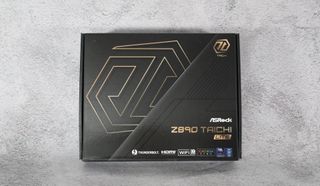
ASRock options a number of gear to get you going: SATA cables (4), the Wi-Fi antenna, three thermistor cables, an ARGB splitter, and ultimately M.2 screws and standoffs. It’s not missing one thing, nevertheless you don’t get loads of extras.
Design of the Taichi Lite
Like all Z890 boards, the Z890 Taichi Lite moreover receives a facelift. The board continues to be on a black, server-grade, 8-layer PCB with and marketed 2 ounces of copper and makes use of “XXL heatsinks” on the VRMs. The underside of the board makes use of a plate-style heatsink to relax the 4 M.2 sockets and chipset beneath, all with a brushed aluminum finish. The PCIe 5.0-capable M.2 socket makes use of a toolless multi-layer heatsink. ASRock modified from black heatsinks to silver proper right here, and the cog/gear theme stays a staple throughout the Taichi lineup, stenciled in black on most metallic surfaces.
Should you occur to’re in quest of built-in RGBs, you’ll have to step as a lot because the pricier Taichi, or buy a definite board, as this one doesn’t have any. You should buy and join your particular person to the 4 headers, nonetheless it’s in another case LED-free outside of the power and reset buttons and the Dr. Debug present. Basic, we like what we see, and the neutral theme ought to combine in with most assemble themes.
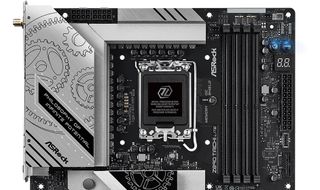
Throughout the larger left nook, we uncover the two high-density 8-pin EPS connectors (one wished) to vitality the processor. The “XXL” heatsink won’t be actively cooled like on the Taichi, nevertheless nonetheless works great for gaming or totally different mainstream duties. Earlier the socket house, sooner than the DRAM slots, is the first 4-pin fan header (of eight), with two additional throughout the nook. The CPU_FAN1 helps as a lot as 1A/12W, whereas the rest of the headers can output as a lot as 3A/36W. There’s a great deal of vitality for AIOs and even custom-made water cooling configurations.
The 4 DRAM slots have locking mechanisms on both facet and don’t use any reinforcement. ASRock lists functionality as a lot as 256GB, with hastens DDR5-9600(OC)+. Our check out system had no factors working any of our kits, along with the earlier DDR5-8200 Kingston and GSkill CU-DIMMs kits. With the board rated to DDR5-9600, there’s nonetheless loads of headroom left if you would like additional.
Cruising down the appropriate edge, we run into the first two 3-pin ARGB headers, with the third ARGB and a single 5-pin RGB header on the underside edge. ASRock’s Polychrome Sync utility controls any connected RGB strips or appropriate {{hardware}} (equivalent to RAM and video card RGBs). Slightly below that is the Dr. Debug present to help with POST factors (and reads temperatures in Dwelling home windows), the 24-pin ATX connector to vitality the board, a USB 3.2 Gen 2×2 (20 Gbps) Type-C header, and ultimately, a 19-pin USB 3.2 Gen 1 (5 Gbps) connector.
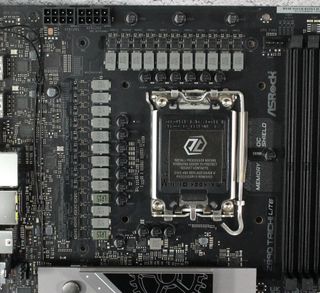
Vitality provide on the Z890 is probably going one of the succesful, consisting of 23 phases with 20 assigned to Vcore. Vitality strikes from the EPS connector(s) to a Renesas RAA229130 PWM controller and onto 20 Renesas R2209004 110A MOSFETs in a ‘teamed’ or ‘twin’ configuration. The 2,220 Amps out there’s hundreds and gained’t get in the way in which by which of overclocking. The primary limitation of this technique is its cooling functionality.
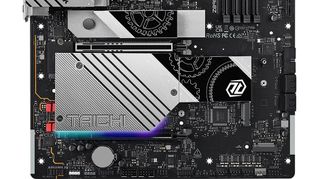
On the underside left-hand side is a completely uncovered audio half based on the flagship Realtek ALC4082 codec and the ESS Sabre219 DAC. Seen are 4 purple WIMA audio capacitors and the ever-present audio separation line.
Within the midst of the board are two full-length PCIe slots and a slew (5 to be precise, with the sixth further to the appropriate) of M.2 sockets. The best full-length bolstered PCIe slot connects by the CPU and runs as a lot as PCIe 5.0 x16 speeds nevertheless does help x8.x8 or x8/x4/x4 for risers enjoying playing cards. The underside slot connects by the chipset and runs as a lot as PCIe 4.0 x4. Observe that when this, the underside slot, is in use, M2_4 will be disabled.
Mixed in among the many many PCIe slots and offset to the appropriate are six M.2 sockets. The best socket connects by the use of the CPU and is your solely socket in a position to PCIe 5.0 x4 (128 Gbps). The remaining 5 are all PCIe 4.0 x4 (64 Gbps), with one socket (M2_3) supporting PCIe and SATA-based M.2 modules. The Z890 Taichi moreover presents 4 SATA ports, which must be hundreds, nevertheless down from the eight Z790 provided. Every SATA and NVMe storage help RAID0/1/5/10 modes.
All through the underside of the board are a variety of uncovered headers. You’ll uncover the identical outdated, along with additional USB ports, RGB headers, and further. Beneath is a complete report from left to correct.
- Entrance panel audio
- 4-pin RGB header
- 3-pin ARGB header
- Thunderbolt 5 header
- (2) USB 2.0 headers
- TPM header
- (3) 2-pin temperature headers
- (4) System fan/water pump headers
- Entrance panel
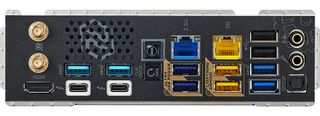
On the built-in backplate, we see an house stuffed with a variety of USB ports and a perforated space to help with VRM cooling. Sporting a black background and grey textual content material, it’s comparatively simple to be taught, and the labels are descriptive, so we’re in a position to’t ask for much extra.
Throughout the middle are a whopping 12 full USB ports, along with 2x Thunderbolt 4 (40 Gbps Type-C, moreover helps video by the use of DisplayPort), 4x USB 3.2 Gen 2 (10 Gbps), 4x USB 3.2 Gen 1 (5 Gbps) and 2x USB 2.0). The same old Wi-Fi 7 antenna connection and HDMI output are on the left. Throughout the middle are the BIOS Flashback and Clear CMOS buttons, the two Ethernet ports, and the audio stack consisting of two 3.5mm jacks (microphone and output) and a SPDIF optical port.
MORE: Best Motherboards
MORE: How To Choose A Motherboard
MORE: All Motherboard Content material materials







